As football fans awaited news of suspended leagues and competitions, LASK Linz hosted Manchester United in the Europa League Round of 16. Linzer Stadion’s eerily empty stands and inclement weather served as hosts for one of the last football matches before the near-global suspension.
Sitting atop the Austrian Football Bundesliga’s Championship Group, LASK entered the match in fine form, winning seven while drawing and losing once in their past nine games. Few teams in the world can claim that kind of form, but Manchester United is one of them. In fact, since the club signed Bruno Fernandes on January 29th, United have won seven and drawn three. Despite LASK’s excellent form, The Red Devils jumped out to a two-goal lead before piling on in the final ten minutes of the match, claiming a resounding 5-0 victory.
In this tactical analysis, we’ll examine the tactical approaches of each team, looking especially at the similarities of their playing philosophies. Given the scoreline, one would assume defensive tactics were skipped in the pre-game meeting, but it really was the focal point for each team as they registered very high PPDA statistics. United’s ability to break the LASK press was the difference-maker in this match, a point we’ll break down in detail.
Lineups
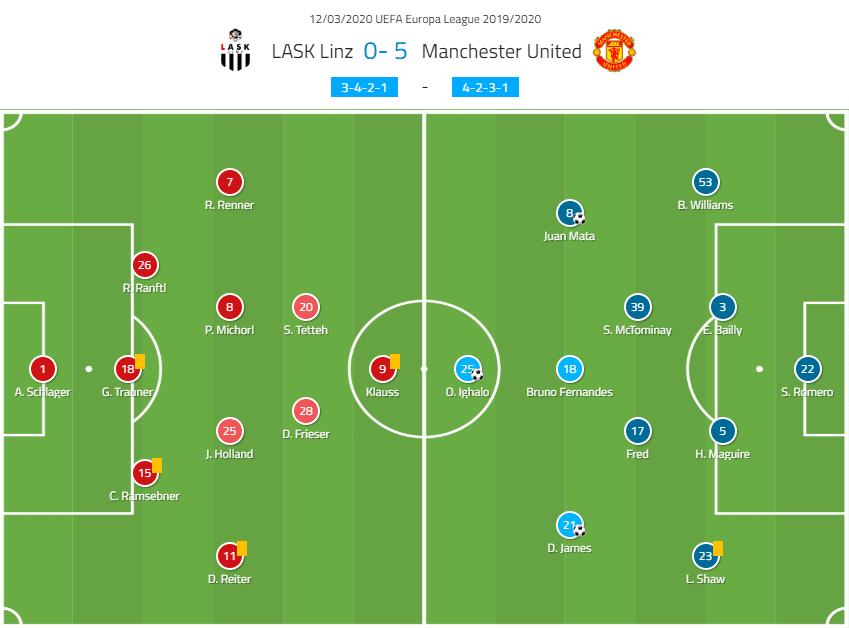
Valérien Ismaël set out his side in their favoured 3-4-2-1. The focal points are domination of the central channel, numbers around the ball ready to counter-press and outlets to the wide players. Alexander Schlager started in goal with the backline of Reinhold Ranftl, Gernot Trauner and Christian Ramsebner at the back. René Renner was the left-midfielder, serving as the team’s primary outlet for progression into the final third. Accompanying him in the midfield were Peter Michorl, James Holland and Dominik Reiter. Klauss was the striker with Samuel Tetteh and Dominik Frieser playing just beneath him in defence and typically on either side of the centre-forward when LASK was in possession.
It was a 4-2-3-1 for United as Ole Gunnar Solskjær went with his Cup keeper, Sergio Romero in goal. Helping him earn the clean sheet was a back four consisting of Luke Shaw and Brandon Williams on the wings with Harry McGuire and Eric Bailey in the centre. Scott McTominay and Fred played the double pivot and played key roles helping the side play out of LASK’s aggressive high press. Fernandes played the #10 with Daniel James and Juan Mata to his left and right, respectively. James had a standard wing role while Mata started wide in the build-up before moving centrally as United entered the final third. Finally, Odion Ighalo made the start up top, repaying his manager’s faith with a fantastic goal.
Positional imbalances
Positional imbalances were one of the more interesting tactical features of this match. For the home side, the 1-3-4-2-1 played out more like a 1-5-2-3 out of possession, then defaulting to the listed formation when in possession. In addition to Tetteh and Frieser generally lined up beside Klauss, both central midfielders play very high up the pitch, giving LASK five players high in the central channel and half-spaces. That opened up the wings for the outside-midfielders.
Reiter tended to stay further back which is in large part due to United’s tactics, which we’ll discuss momentarily. With Reiter sitting deeper, Renner pushed high up the pitch, operating as the wide outlet. Die Laskler frequently looked to the left side of the pitch to progress up the field, funnelling 25 of their 46 attacks in that direction. Unfortunately for the Austrians, none of Renner’s team-leading five crosses found their targets. In fact, the home side did not complete any of their 11 crosses.
With three of the four LASK Linz midfielders playing so high up the pitch, United’s attacking midfielders had to adjust their shape. James tended to play in line with Ighalo. The Welshman started high and wide, forcing Reiter to remain further back in support of Ramsebner. Ighalo was typically marked by two defenders in the centre, meaning Fernandes and Mata found themselves in a massive gap between the LASK defensive and midfield lines. With LASK aggressively pressing high up the pitch, any outlet to the two Iberians typically led to an even numbers counterattack. Mata’s positioning was fantastic, balancing the high and wide role in the build-up with a more central, box midfield type starting point. He attacked almost exclusively from the right half-space as Man U entered the final third. On the night, United sent only seven crosses, completing three. This gives an indication of Solskjær’s tactic’s to prioritize higher quality chances through the centre.
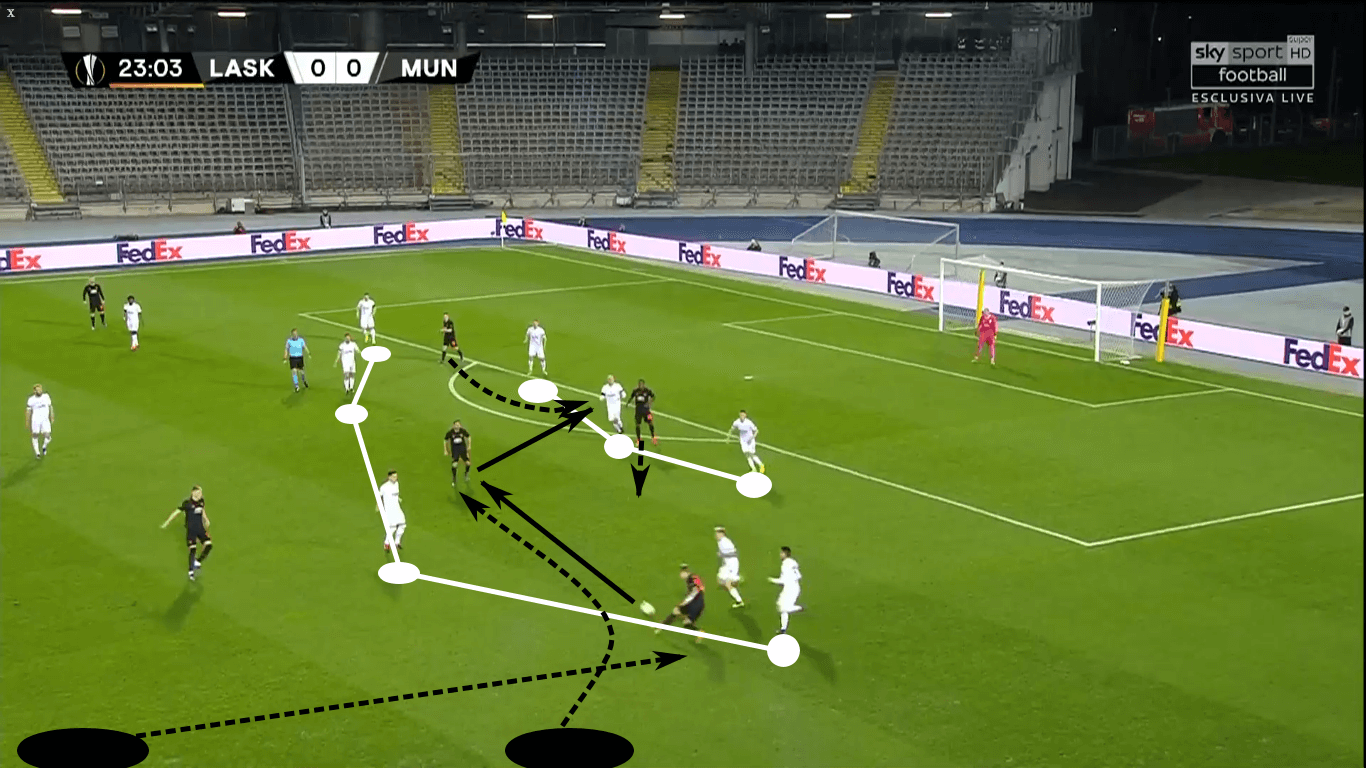
During this particular Manchester build-up, Williams took a throw-in on the right-wing, sending the ball to Fred, who immediately switched play to Shaw. The Englishman was alone on the left-wing and aggressively attacked the open space in front of him. While he advanced up the pitch, Mata pinched further inside to overload the middle, freeing the right-wing for Williams to advance. After completing a switch of play back to the right-wing, Williams took a touch away from pressure and sent a pass to Mata. Ighalo’s checking run cleared the middle, allowing the Spaniard to play the inside run of James. In a move that closely mirrored his second-half goal, the Welshman cut to his right and fired a shot on frame, one that Schlager did well to save.
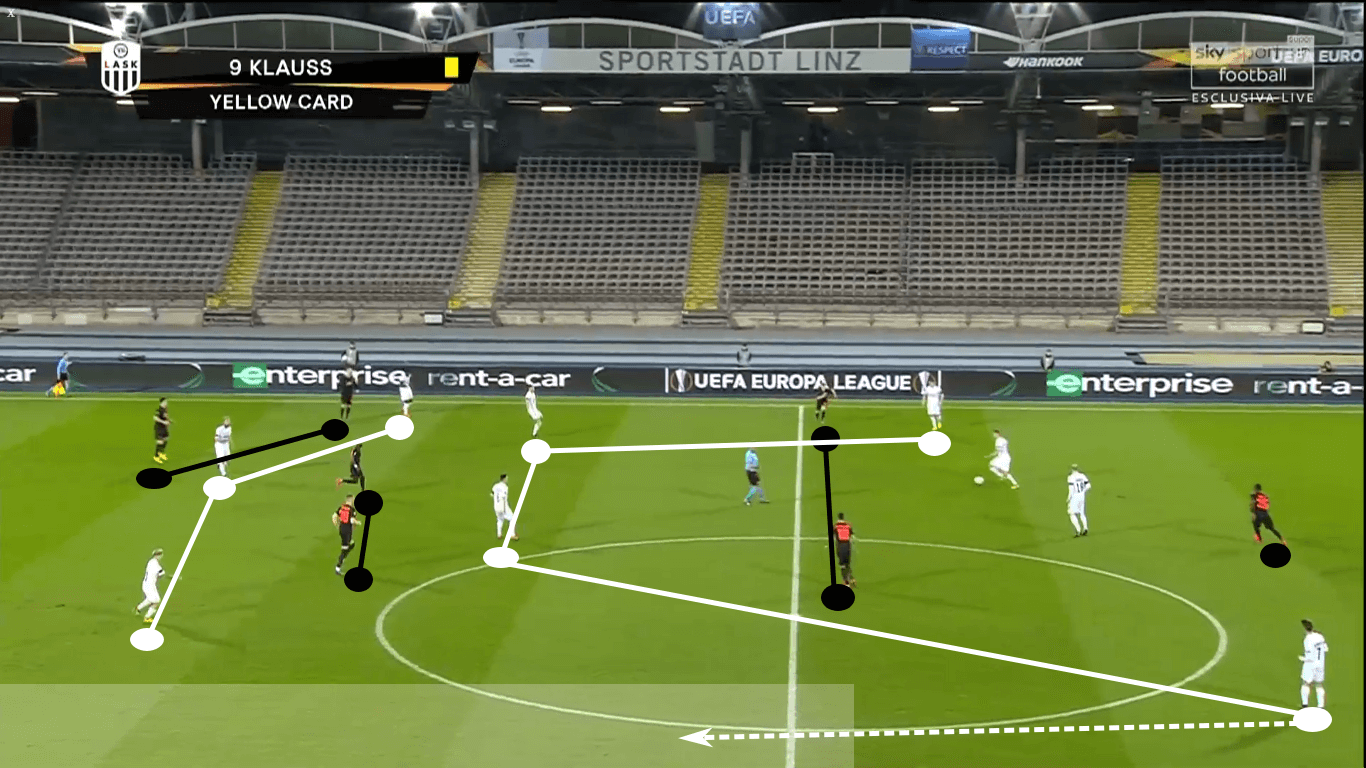
As Ramsebner intercepts a Shaw pass, we see LASK transitioning from its middle block to attack. Notice the outside-backs are in line with the defenders, giving the Austrian club a 1-5-2-3 set up. The pitch is also very compact, meaning LASK have short-range options to keep possession, but now they must work to create a passing lane to one of the outlet players. A couple of things to note are the absence of Mata, who generally took up a high and wide position as United build out, and the space available for Renner. Ideally, LASK would like to get the ball to him in the highlighted area, cueing his forward progress.
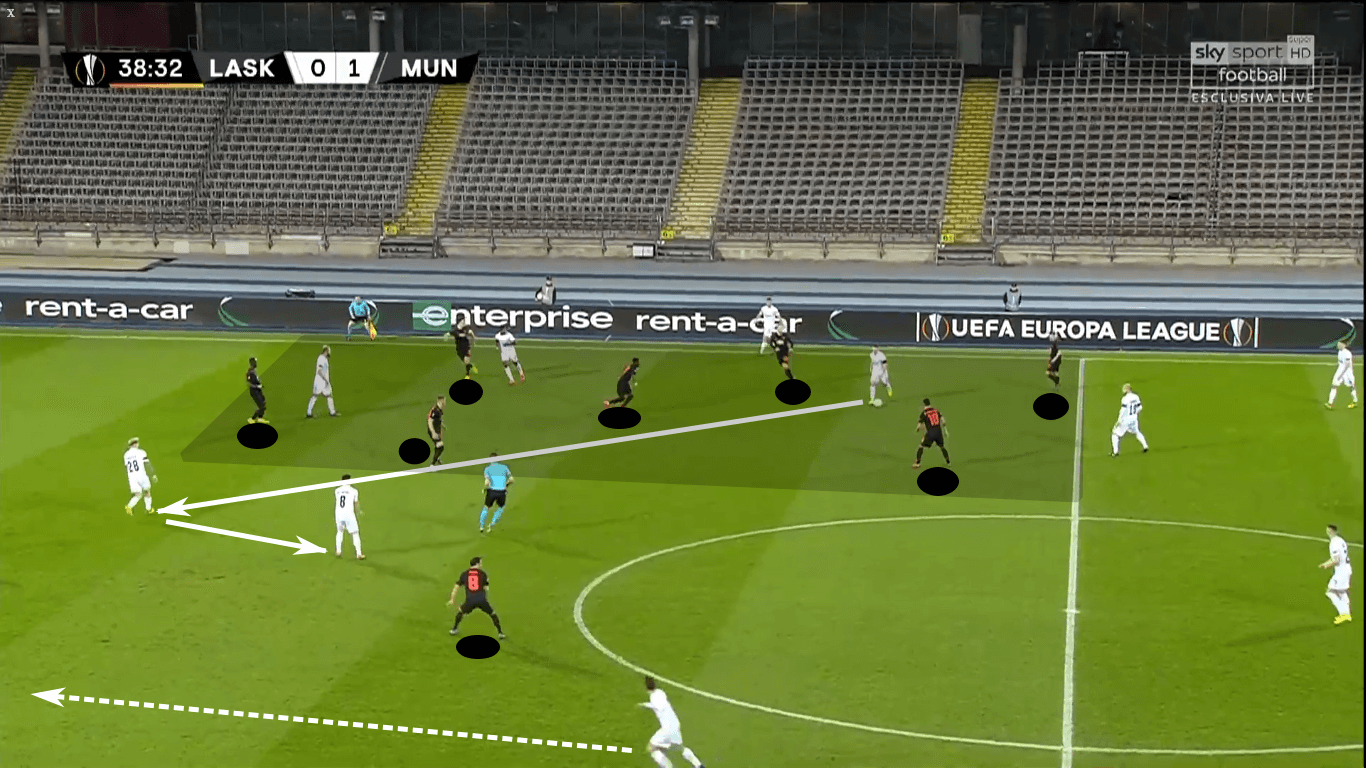
Manchester United were quick to make the field compact, especially in their left-wing. With seven players in that shaded area, they are well-prepared to pressure the ball-carrier. However, first defender pressure is slow to arrive, gifting LASK time to identify an outlet. Reiter played to Frieser (his left-forward who’s ventured into the right-half space), who set for Michorl. At the bottom of the image, Mata sees Renner ready to sprint forward.
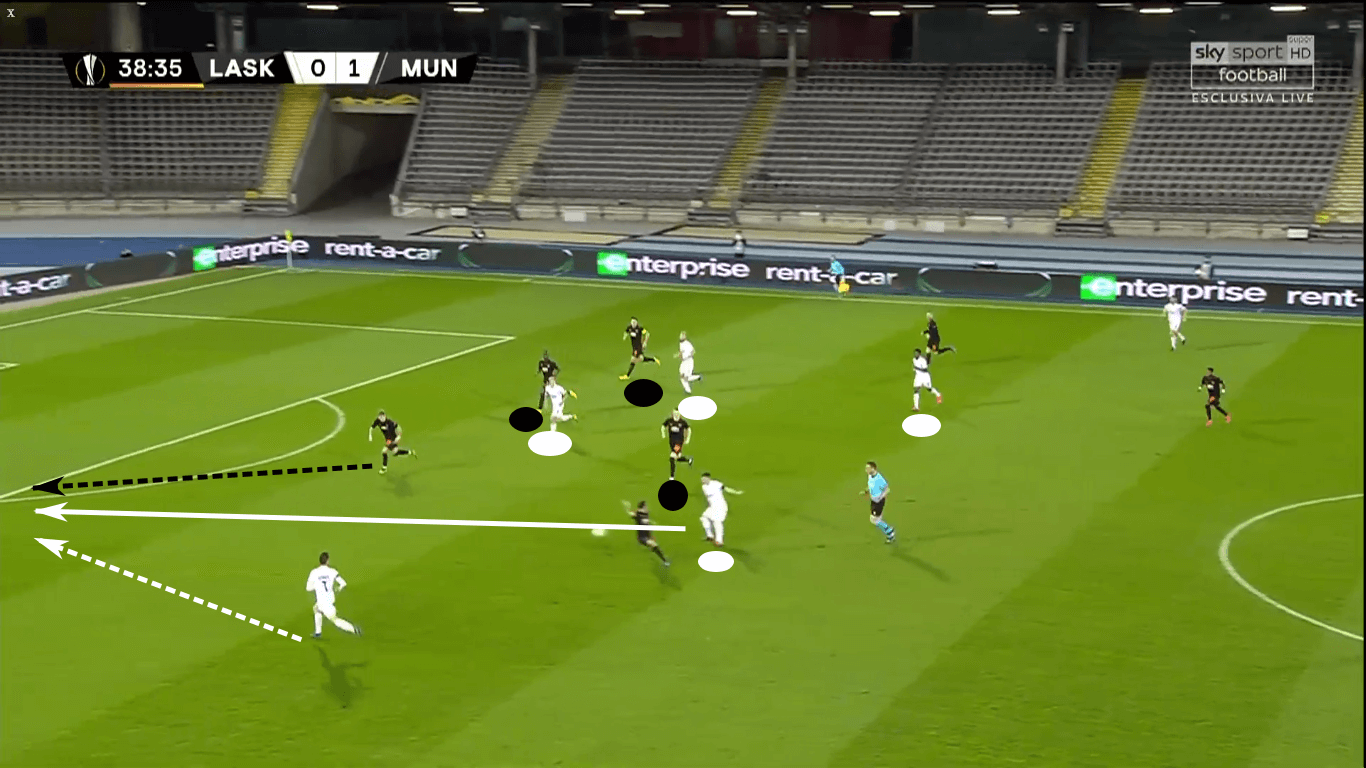
Mata opts to challenge Michorl rather than follow the runner. It’s the right decision, but his pressure is too slow to arrive, allowing the split. The pass was just beyond Renner, giving Williams time to recover and apply pressure. In the end, LASK was only able to muster a blocked shot from 25 metres as poor execution ended a promising attack.
Direct, end-to-end action
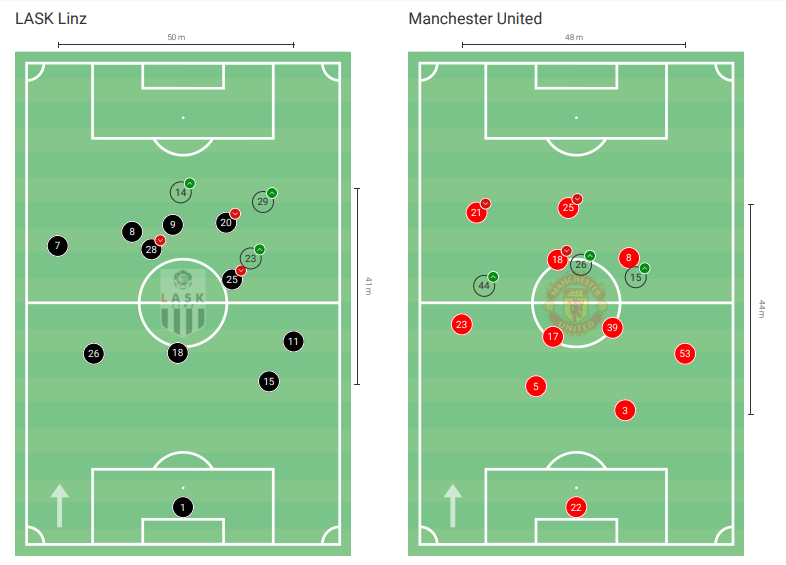
As mentioned in the introduction, defensive tactics were the starting point for each team. LASK lives and dies by the counter-press. They’re incredibly aggressive, committing as many numbers forward as possible to ensure a quick and easy defensive transition. Looking at their starting positions, you can see the clear tactical emphasis on commanding the centre of the pitch. Draw a 15 metre square around the central midfielders and forwards and, like a kid playing Pokémon Go, you’ll catch ‘em all. The central overload serves three important purposes: 1) high targets with numbers in support, 2) getting numbers into the box, especially if they’re expecting a cross and 3) quick transition to counter-press. For the game, Die Schwarz-Weißen managed a 7.7 PPDA for the game with a stat of 9.2 in the first half, 6.6 in the second.
An analysis of Manchester United starting positions shows the box midfield that was mentioned in the previous section. Comparing the starting points of the wide players in the 1-4-2-3-1 gives an idea of United’s approach. James and Ighalo aimed to occupy four players, creating space for the midfielders and Williams. Those three and Tahith Chong were excellent on the dribble, winning 15 of 24 1v1s (63%). The combination of LASK’s counter-pressing and the starting points of Fernandes and Mata meant United typically looked to play more directly.
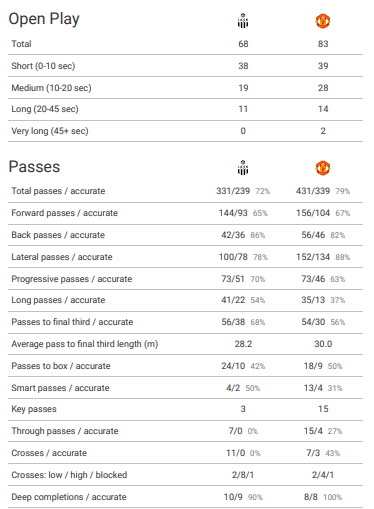
It was a highly transitional match with Man U recording 134 losses and LASK chipping in with another 125 more. The Austrians side’s losses were so high because United was quick to counter-press as well, averaging 8.4 PPDA for the game. With both teams so eager to beat the counter-press, possessions tended to be quick and direct. The image above shows only two possessions lasting longer than 45 seconds. That’s a shocking number for this level of play, but also an indicator of the tactical systems. Forward passes account for 44% of LASK’s attempts. For reference, in a recent 2-1 win over Real Madrid, Real Betis played 35% of passes forward while Los Blancos hit 31%.
Key and through passes are another positive indicator for Manchester. Though only four of 15 through passes connected, the stat, in conjunction with the low number of crosses, indicates that The Red Devils were looking for central penetration through Fernandes and Mata. Overall, United was highly successful on the night, completing 15 key passes and 22 shots, 11 of which were on target.
United breaks LASK’s aggressive press
After a reasonably slow start from both sides, United continuously threatened the LASK goal from the 18th minute onwards. In the final 77 minutes of the game, Man U averaged a shot every 3.8 minutes. Long spells of dominance in the middle of each half produced two of the five goals. The last three came in the final 10 minutes of the match.
The primary reason the English Premier League side created so many dangerous chances on goal was down to their ability to break LASK’s counter-press. As mentioned, this was a highly transitional, end-to-end type game. The moment either side lost the ball, they quickly counter pressed and had much success causing turnovers.
In response to the LASK pressure, Manchester started playing more lateral and backward passes to evade pressure. Once they were able to play that first pass out of pressure, the next pass often targeted the higher positioned players, especially Fernandes and Mata who typically found space between the lines and forced the LASK backline to step high and pressure. Playing that first pass out was just the first step in breaking the counter-press. The second was relying on individual qualitative advantages to beat a defender and run at the backline. Manchester United did that very well and often in this match. On the night, United won the xG battle 2.55 to 0.30.
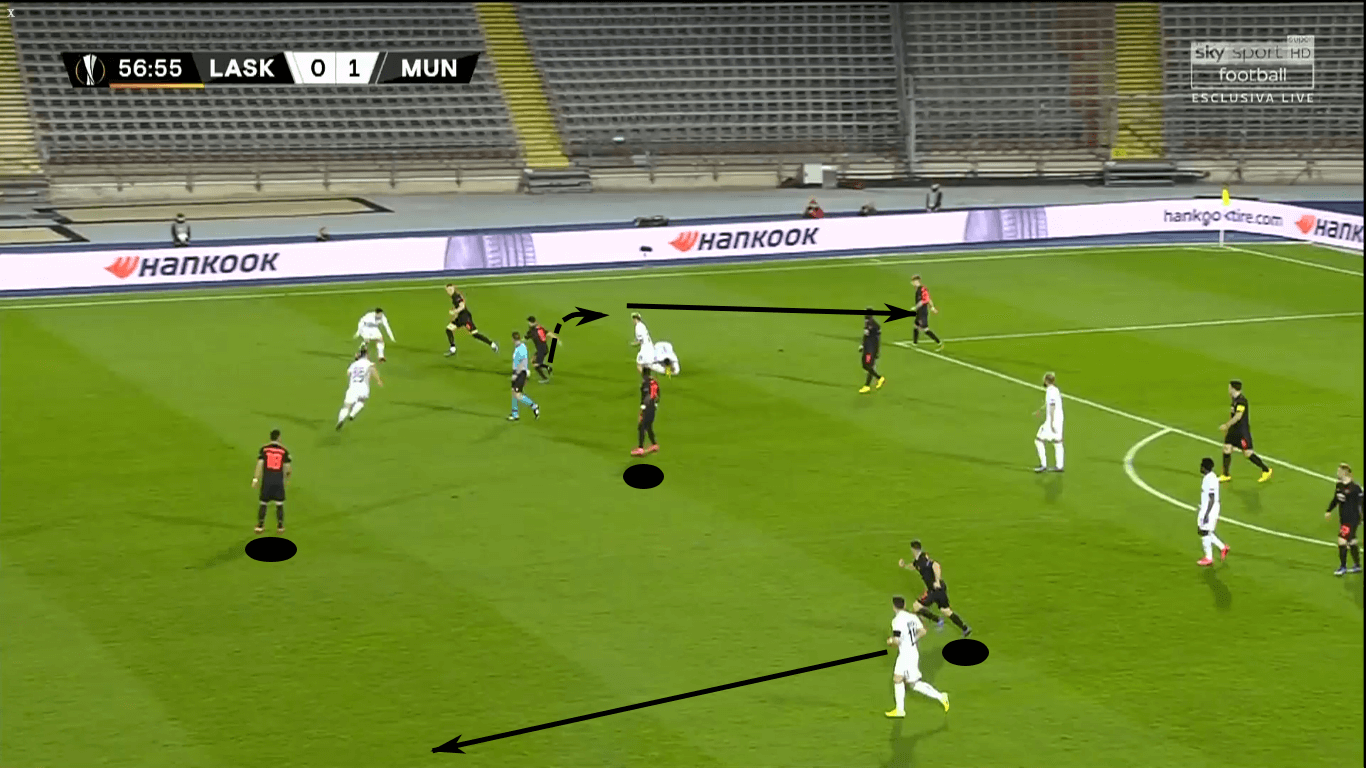
Upon revering the ball, Mata spun away from pressure and dropped the ball to Williams. Notice the number of players LASK had around the ball immediately following the turnover. In their hurry to recover the ball, Fred and Fernandes were left alone centrally. At the bottom of the image, James is starting his run forward.
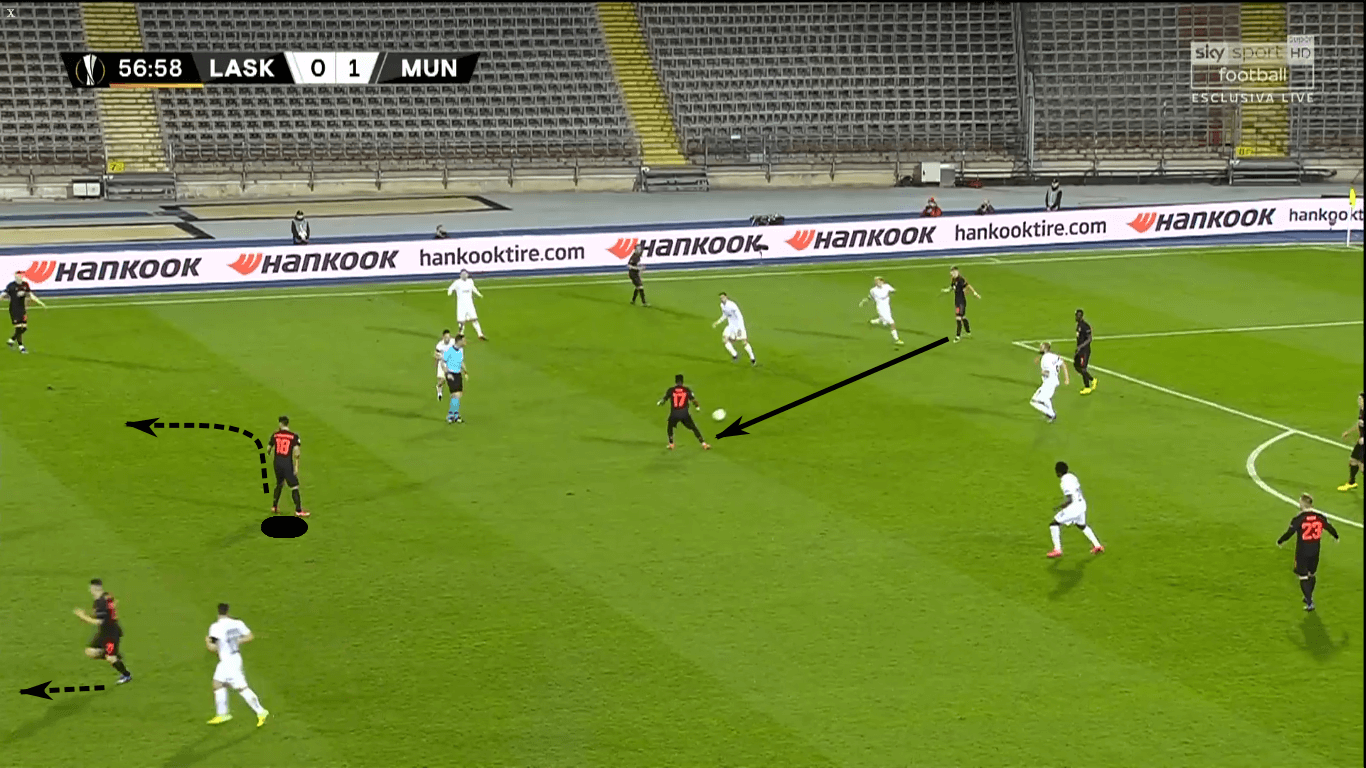
Williams was able to break LASK’s pressure, playing to Fred, who was able to turn into space. A couple of other interesting notes in this image are the continued run of James and the shoulder check of Fernandes. What you can’t see is the checking run of Ighalo. As he checks into the area occupied by Fernandes, the Portuguese vacates the middle, pulling the nearest defender into the half-space with him, leaving Ighalo alone in the middle.
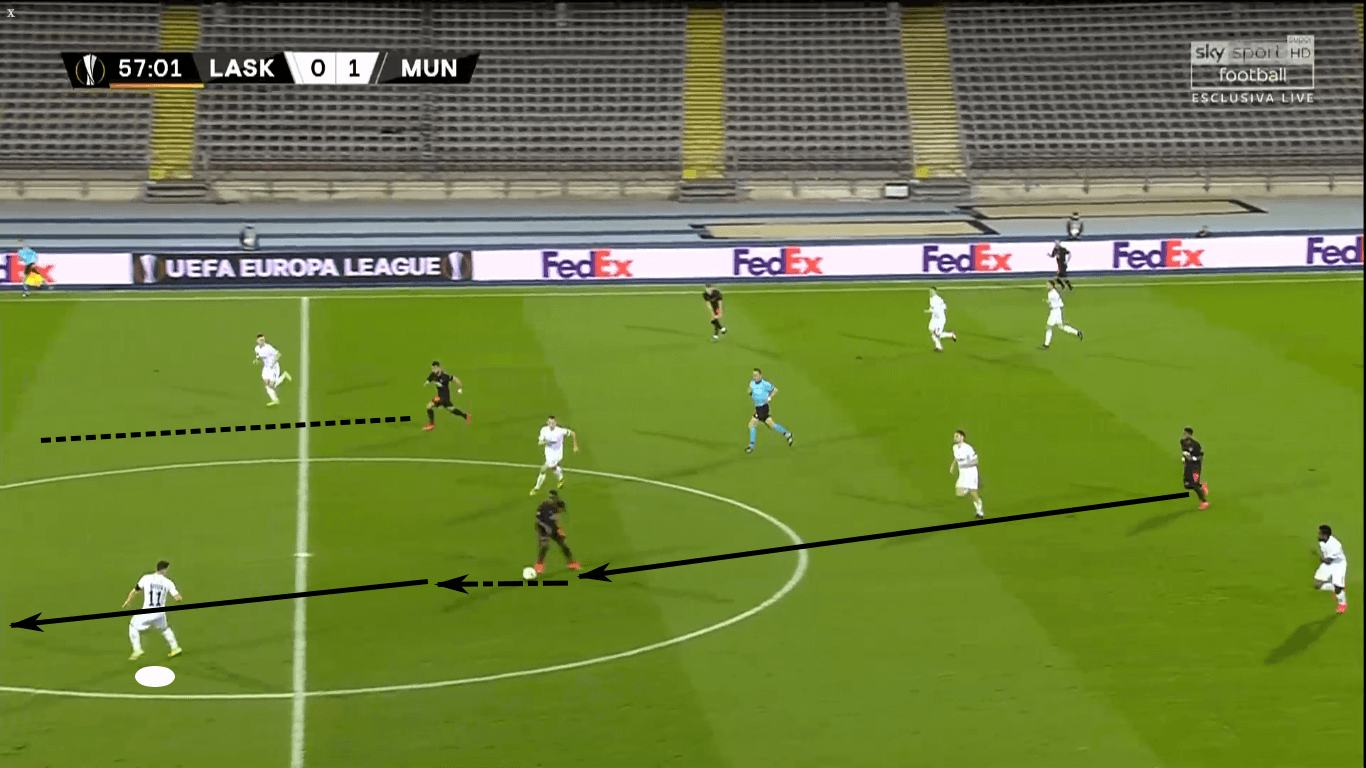
As Fred’s pass was played to Ighalo, Reiter found himself in no-man’s-land. With James already beyond him, the Austrian stepped forward to Ighalo. That allowed the Nigerian to play a through ball to James. Additionally, the pass the Ighalo pulled Remsebner away from Fernandes, giving him the inside route to goal against Ranftl.
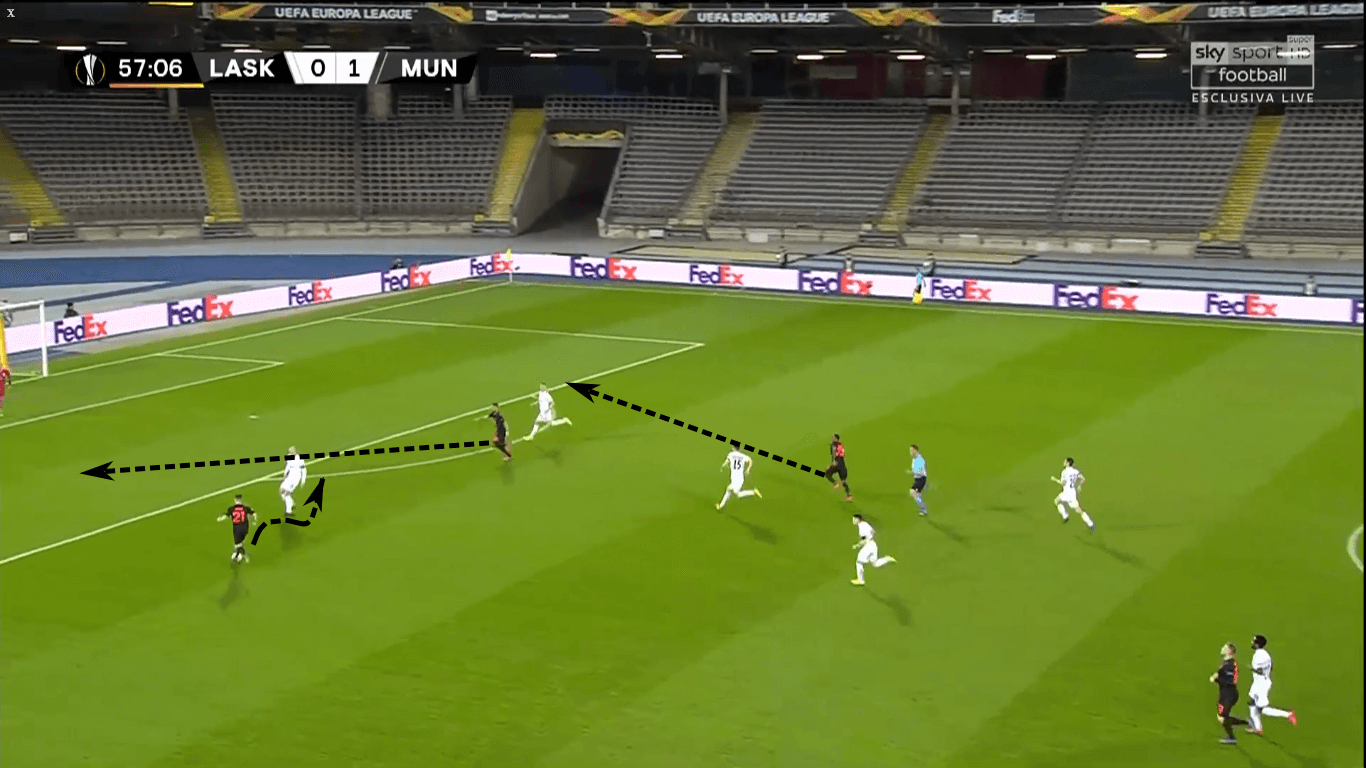
James collected the ball and cleverly waited for the run of Fernandes. This run forces Trauner to hesitate, allowing James to beat him to the inside. The youngster’s shot beat Schlager at the near post, giving United a two-goal cushion.
Conclusion
Though a tighter clash was expected, Manchester United ran away with this result largely due to resolute defending and superior individual quality. Unlike in the Austrian Bundesliga, LASK really to tackle effectively and beat the United counter-press. Chances were few and far between for Ismaël’s men. Heading into an indefinite break, LASK couldn’t have put in a worse performance. The players, staff, and fans will have far too much time to dwell on this result.
Manchester United will also hope for a quick return to the pitch. With the side on an incredible hot streak, this is really unfortunate timing. When, possibly if, we return to football in the 2019/20 season, Man U will have their eyes firmly set on top four qualification (with or without City’s legal status) and another Europa League title.
Until better days return and the pandemic is under control, the global football community must turn its attention to the health and well-being of their families, friends, and communities. Protect yourself and your community by following the World Health Organization’s Coronavirus guidelines, but, also, keep an eye out for those in need of support. Please take the time to check in with family, friends, and neighbours, especially the elderly as they are most at risk.





Comments